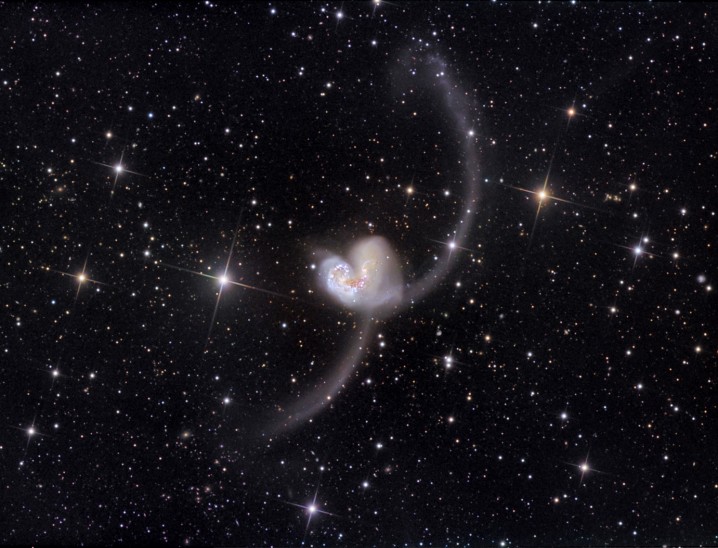
|
Credit & Copyright: Daniel Verschatse
(Antilhue Observatory)
Explanation:
Some 60 million light-years away in the southerly
constellation
Corvus, two large galaxies
have collided.
But stars in the two galaxies -
NGC 4038
and NGC 4039 - don't collide
in the course of the ponderous, billion year or so
long
event.
Instead, their large clouds of
molecular
gas and dust do, triggering furious
episodes of star formation.
Spanning about 500 thousand light-years,
this
stunning view
reveals new star clusters and
matter flung far from the scene
of the accident by gravitational tidal forces.
Of course,
the visual appearance of the far-flung arcing structures
gives the galaxy pair their popular name - The
Antennae.
Recorded in this deep image of the region at the tip of the upper arc
is a tidal dwarf
galaxy NGC 4028S, formed in the cosmic debris.
|
January February March April May June July August September October November December |
| ||||||||||||||||||||||||||||||||||||||||||||||||
NASA Web Site Statements, Warnings, and Disclaimers
NASA Official: Jay Norris. Specific rights apply.
A service of: LHEA at NASA / GSFC
& Michigan Tech. U.
Based on Astronomy Picture
Of the Day
Publications with keywords: NGC 4038 - colliding galaxies
Publications with words: NGC 4038 - colliding galaxies
See also:
- APOD: 2025 May 7 Á Galaxy Wars: M81 versus M82
- APOD: 2024 July 30 Á Arp 142: Interacting Galaxies from Webb
- APOD: 2024 February 7 Á The Heart Shaped Antennae Galaxies
- APOD: 2023 September 25 Á Arp 142: The Hummingbird Galaxy
- APOD: 2023 January 23 Á The Colliding Spiral Galaxies of Arp 274
- Galaxy Wars: M81 and M82
- NGC 1316: After Galaxies Collide
